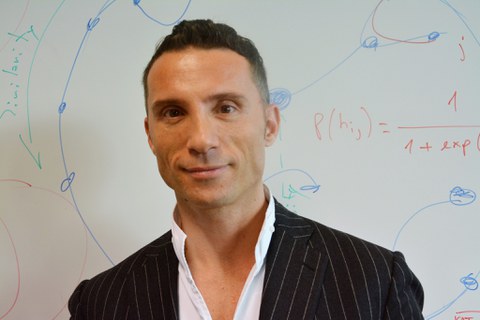May 08, 2018
Sunshine duration might influence the time onset of a deadly type of heart attack

Dr. Carlo Vittorio Cannistraci
An international team of scientists led by Dr. Carlo Vittorio Cannistraci, Group Leader of the Biomedical Cybernetics lab at the BIOTEChnology Center (BIOTEC) TU Dresden, has discovered a rule at the basis of the chronobiology of heart attack in humans. The study concludes that seasonal rhythms associated with sun irradiance may influence circadian rhythms of heart attack onset.
ST-elevation acute myocardial infarction (STEMI) - sometimes termed massive heart attack – occurs when an artery leading to the heart muscle is completely blocked and a large portion of the heart cannot receive blood. As a consequence the heart muscle tissue in that area quickly begins to die. In the United States, between 2006 and 2011, emergency rooms saw an average of 258,106 STEMIs each year, and STEMI represents one of the leading causes of human death.
The fact that onset of STEMI has a circadian rhythm with a peak during diurnal hours is well described in scientific literature as a general rule of heart attack. Equally important is a second rule which suggests that a seasonal rhythm in the occurrence of STEMI is also present with a salient peak of cases in the winter months and a marked nadir of cases in the summer months. Thus, environmental and climatic factors may play an important part in STEMI pathogenesis.
However, it is unknown whether the circadian rhythm is modified by the seasonal rhythm in particular during the summer reduction in STEMI occurrence. Dr. Carlo Vittorio Cannistraci, together with Dr. Enrico Ammirati from the Niguarda Hospital Milano (Italy), have conducted a study that, for the first time, investigated this topic analysing data coming from thousands of patients that had suffered heart attack across the world. The results of this multi-ethnic and multi-nation epidemiological study, which considers patients from both hemispheres at different latitudes, concludes that the circadian rhythm of STEMI time onset varies over the year, showing a dependency from the seasonal and sunshine rhythms. In particular, the study spotted that in summer the time of STEMI onset shifts significantly to the nocturnal interval (18.00 – 6:00) and this phenomenon named by the Authors as ’summer shift’ seems associated with sunshine duration (different from the sunlight duration, which is the mere number of hours with light in a day), which is a measure inversely related to cloudiness and directly related to solar irradiance duration. This discovery might become a third pillar in the definition of the general rules that characterize the chronobiology of heart attack.
Carlo Vittorio Cannistraci, the first author, commented: “After we discovered the presence of this summer shift, one point was still ‘obscure’ in the study. What are the climatic factors that are associated with the summer shift? Then, I had an intuition: having a cohort from Singapore could be crucial, because at that latitude the temperature and sunlight duration can be considered constant along the year, therefore the summer shift should be assent. Astonishingly, we found that shift of STEMI occurrence (named STEMI shift) from diurnal to nocturnal interval was directly correlated with measures of sun irradiance. Therefore, also the ‘summer shift’ in region far to the equator could be associated to the level of irradiance at that latitude. To have a conclusive proof, we checked the correlation of the discovered STEMI shift across the year in the Finnish cohort with the serum levels of vitamin D (which is a natural marker for sun irradiance) at that latitude. This last analysis suggested that when the vitamin D increases in the serum during the summer, due to the higher level of sun irradiance, then a consistent number of heart attacks migrate in the nocturnal interval confirming the fact that the summer shift is associated with the levels of sun irradiance along the year. Further studies should now investigate the reasons and molecular mechanisms of this new rule that governs the chronobiology of heart attack“.
The funding was provided by: the Independent Group Leader Starting Grant of the Technische Universität Dresden; the German Research Foundation (DFG) and the Open Access Publication Funds of the Technische Universität Dresden.
Carlo Vittorio Cannistraci is a Theoretical Engineer. He has been Group Leader of the Biomedical Cybernetics group at BIOTEC of the Technische Universität Dresden since February 2014 and he is a TUD Young Investigator (Faculty of Physics) since 2016. His research interests include subjects at the interface between physics of complex systems, complex networks and machine learning theory, with particular interest for applications in biomedicine and neuroscience.
Publication
“Summer Shift”: A Potential Effect of Sunshine on the Time Onset of ST-Elevation Acute Myocardial Infarction.
Carlo Vittorio Cannistraci, Tuomo Nieminen, Masahiro Nishi, Levon M. Khachigian, Juho Viikila, Mika Laine, Domenico Cianflone, Attilio Maseri, Khung Keong Yeo, Ravinay Bhindi, Enrico Ammirati.
Journal of American Heart Association 2018; 7:e006878. DOI:10.1161/JAHA.117.006878.
Media inquiries:
Franziska Clauß, M.A. (Press Officer)
Tel.: +49 (0) 351 458-82065
Fundamental biological discoveries are often driven by technological advances. The Biotechnology Center (BIOTEC) was founded in 2000 and is now one of the three institutes of the central scientific unit Center for Molecular and Cellular Bioengineering (CMCB) and plays a central role in the Health Sciences, Biomedicine and Bioengineering profile of the TU Dresden. The BIOTEC is an interdisciplinary research center that develops innovative technologies driving the progress of modern life sciences in the areas of molecular cell and developmental biology, physical biology, and computational biology. This synergy between technology development and basic research drives the sustained success of basic, applied, and translational research at the BIOTEC and the CMCB, the wider TU Dresden campus and DRESDEN-concept partners. The BIOTEC is also the hub of the Physics of Life Excellence Cluster Proposal of the TU Dresden. https://www.tu-dresden.de/biotec
